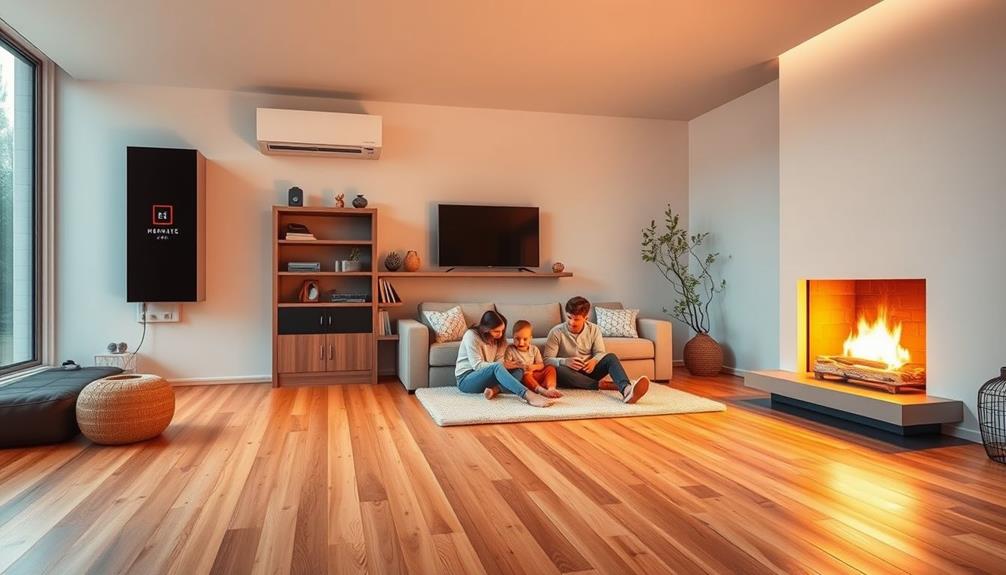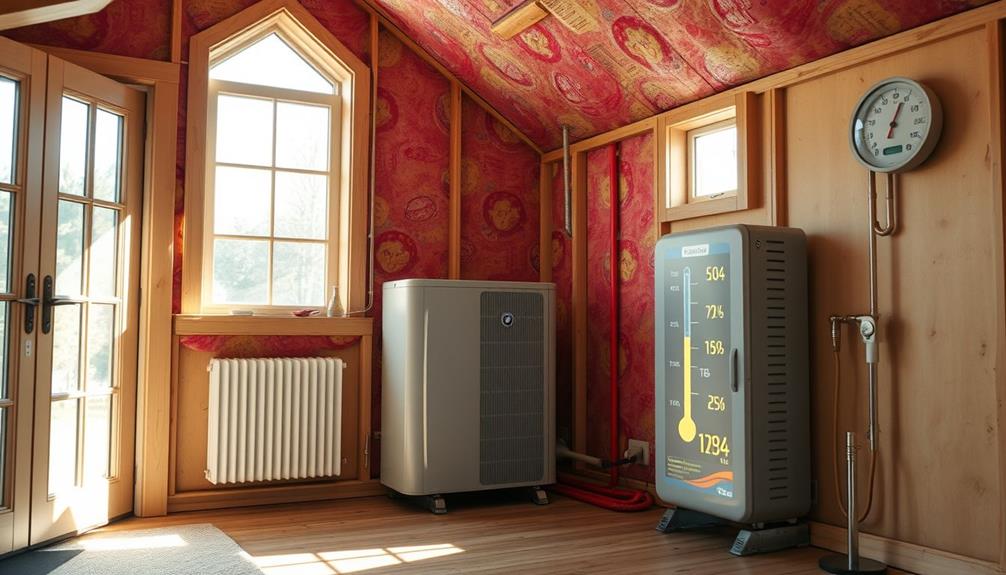Heat pumps and radiant floor heating work together to create a powerful, energy-efficient system for your home. By extracting renewable energy from air or water, heat pumps lower your energy consumption and utility bills. Radiant floor heating guarantees even heat distribution at lower temperatures, maximizing your comfort. Advanced control systems adjust temperatures automatically, maintaining ideal warmth throughout your space. This combination not only enhances your home's energy efficiency but also supports sustainable living. If you're curious about how to maximize this system's benefits, you'll find valuable insights on the next steps ahead.
Key Takeaways
- Heat pumps extract renewable energy, providing efficient heating for radiant floor systems while reducing energy consumption and carbon footprint.
- Radiant floor heating operates effectively at lower water temperatures (30-35°C), ideal for heat pump compatibility.
- Advanced control systems in radiant heating optimize heat pump performance, ensuring consistent warmth and energy efficiency.
- The combination enhances thermal comfort with even heat distribution, eliminating visible radiators and optimizing energy consumption.
- Energy savings can reach up to 30% compared to traditional heating methods, making this combination a sustainable choice.
Advantages of Heat Pumps
When you consider efficient heating options, heat pumps stand out because they extract renewable energy from the environment—whether it's air, water, or ground. This method results in considerably lower energy consumption compared to traditional heating methods, making heat pumps an eco-friendly choice.
In addition, understanding thermal energy transfer basics enhances the efficiency of heat pumps, ensuring ideal performance. When combined with radiant floor heating, they create an effective system that operates at lower design temperatures, maintaining warmth with less energy input.
One key advantage of heat pumps is their ability to replace gas or electric boilers, aligning with modern energy efficiency standards. They not only reduce your carbon footprint but also lower your utility bills.
Moreover, incorporating larger buffer tanks in your radiant floor heating system can minimize the short cycling of heat pumps. This means they can operate more efficiently, enhancing their overall performance and longevity.
Radiant Floor Installation Options

Radiant floor heating offers several installation options to suit different building designs and personal preferences. You can choose from various methods to implement hydronic heating effectively. For instance, concrete slab installation provides ideal mass for heat retention, making it highly effective for radiant floor systems.
If you're looking for consistent thermal performance, a suspended slab installation guarantees effective heat distribution while maintaining good mass. Additionally, integrating effective pool maintenance equipment can help maintain a comfortable environment in your home, enhancing overall comfort.
If you're retrofitting existing floors, staple-up installation could be your best bet. This method uses aluminum plates for efficient heating and is practical for many homes.
Alternatively, the plywood and plates installation allows flexibility, as it can be set up above the subfloor, accommodating various architectural designs.
When weighing heat pump vs. radiant floor options, consider the installation options that fit your specific needs. Each method has unique advantages, allowing you to customize your heating solution.
With these choices, you can enhance comfort while boosting energy efficiency in your space. By selecting the right installation option, you'll guarantee that your radiant floor system works seamlessly with your heat pump, creating a powerful and effective heating combination.
Hydronic Control Systems
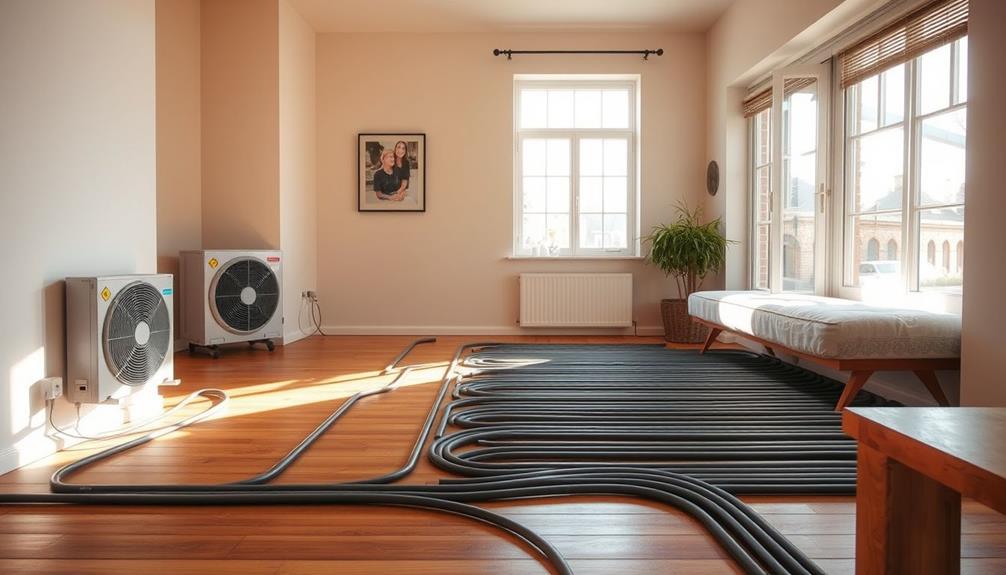
Hydronic control systems play an essential role in optimizing the performance of heat pumps in radiant floor heating setups. They manage the operation of the heat pump, ensuring that your home maintains the perfect temperature while enhancing overall energy efficiency.
With these systems in place, you'll enjoy consistent warmth, as they autonomously adjust the heat pump's operations to meet the specific heating demands of your underfloor system. Additionally, investing in energy-efficient technologies aligns with the latest trends in healthy living, contributing to a more sustainable lifestyle.
Advanced controllers within hydronic systems enable real-time monitoring and adjustments, meaning they can respond swiftly to any changes in temperature. This capability noticeably reduces your overall energy consumption, helping you save on utility bills.
When properly integrated with heat pumps, hydronic control systems allow your system to operate at lower water temperatures, which not only boosts efficiency but also increases your comfort.
Investing in modern hydronic management systems can lead to remarkable energy savings and improved performance of your combined heat pump and radiant floor heating system. By choosing to enhance your heating setup with these controls, you're not just investing in technology; you're investing in a more comfortable and energy-efficient living space.
Energy Efficiency Benefits
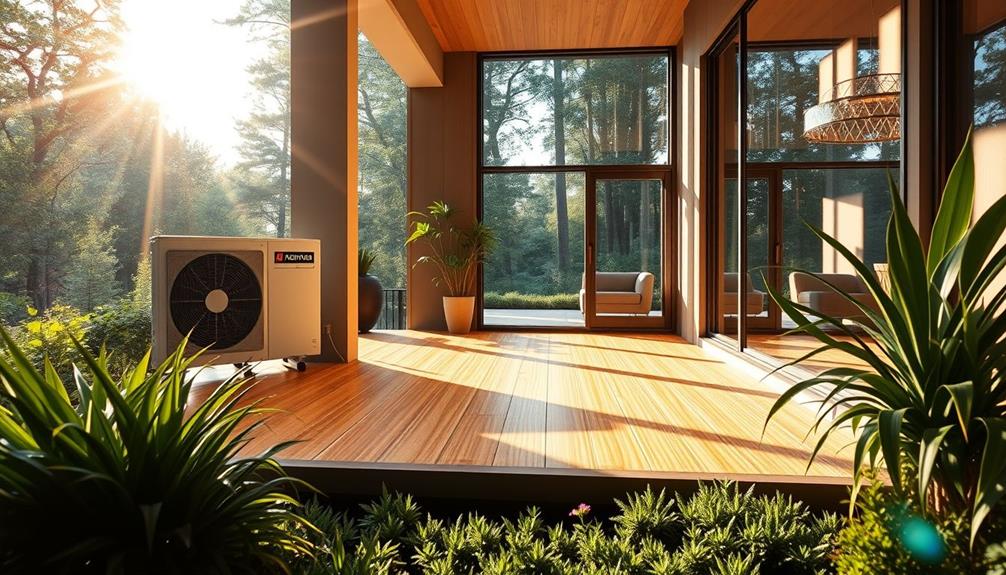
Heat pumps combined with radiant floor heating offer impressive energy efficiency benefits that can greatly lower your energy bills. With heat pumps achieving energy efficiency ratings of 350-450%, they substantially outperform traditional high-efficiency boilers, which only operate at around 95% efficiency.
This remarkable performance is enhanced when you use radiant heating systems, as they require lower water temperatures—often as low as 30-35°C—which means your heat pump can run more efficiently. Additionally, the integration of these systems aligns with the principles of geothermal energy generation, showcasing how harnessing natural energy sources can lead to sustainable heating solutions.
By integrating underfloor heating with heat pumps, you enjoy even heat distribution throughout your space, leading to improved thermal comfort.
Plus, this setup eliminates the need for visible radiators, further optimizing energy consumption. The combination of these technologies not only reduces your energy bills but also supports a more sustainable energy solution by utilizing renewable energy sources.
Choosing the Right Heat Pump
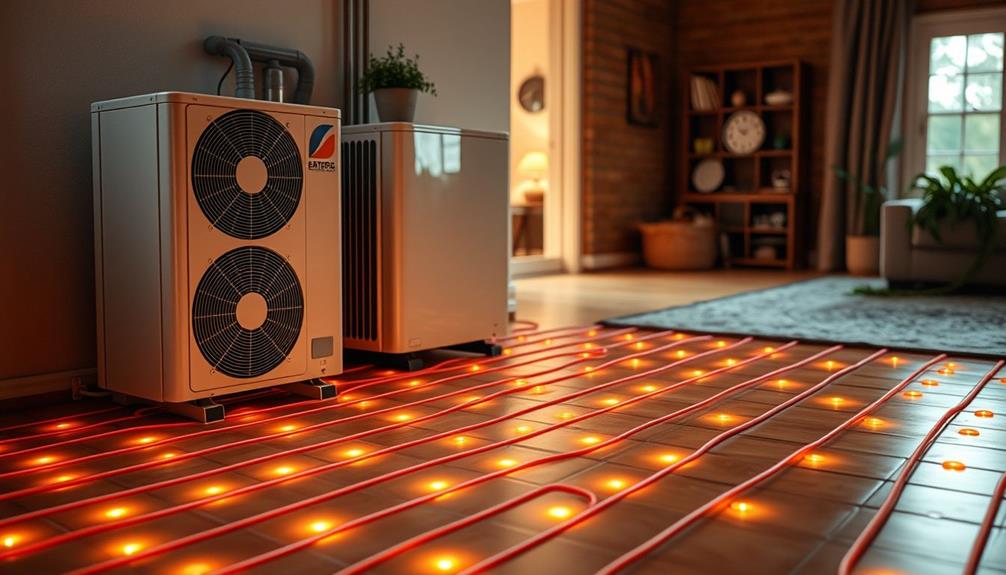
When it comes to selecting the right heat pump for your underfloor heating system, you'll want to focus on air-to-water models for their straightforward installation and low operating costs.
These air-to-water heat pumps are particularly effective at maintaining the recommended supply temperature of 30-35°C, which is ideal for underfloor heating.
It's vital to take into account your building's specific heating design and insulation properties. A professional consultation can help you determine whether an air-to-water or a water heat pump is the best fit for your needs.
Each option has its benefits, with water or ground source heat pumps offering efficient heating solutions as well.
Before making your final decision, assess the thermal properties of your building. Proper compatibility with the heat pump and the underfloor heating system is essential for peak performance.
Optimizing System Performance
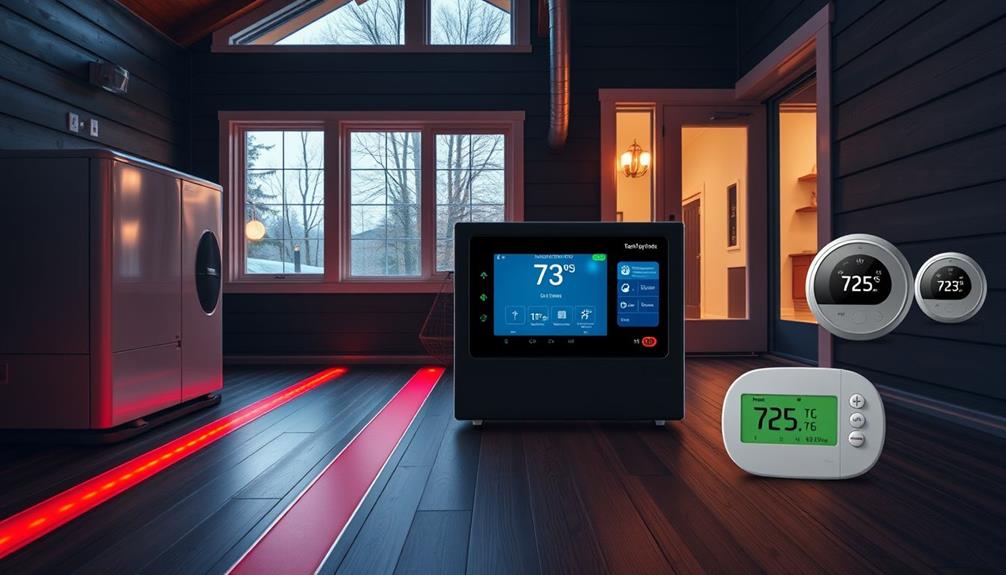
To optimize the performance of your heat pump and radiant floor heating system, you need to focus on key design considerations and effective temperature management strategies.
Implementing advanced control technologies can also help tailor the system to your specific heating needs, ensuring energy efficiency.
Additionally, maintaining good indoor air quality is essential for overall comfort, which can be achieved through using ozone air purifiers to eliminate allergens and unpleasant odors.
System Design Considerations
Optimizing system performance for a heat pump paired with radiant floor heating hinges on several vital design considerations. First, proper insulation and thermal properties of the substrate are essential. They guarantee that heat generated by the hydronic radiant system is effectively distributed throughout the space, enhancing energy efficiency.
Additionally, utilizing a well-draining soil mix can inspire better thermal regulation in the system, assuring a more balanced heat distribution best soil for String of Hearts plants.
You'll want to maintain the water temperature within the recommended range of 30-35°C. This prevents discomfort and protects the flooring from potential damage. Implementing a larger buffer tank can also greatly improve your system's efficiency, as it helps maintain the minimum design temperature, assuring stable heat delivery.
Next, consider advanced heating control systems. These can autonomously adjust the heat pump's operation to meet the specific heating needs of your underfloor system, promoting user comfort while saving energy.
Additionally, careful flow rate management is vital. It prevents high return water temperatures that could diminish the heat pump's performance.
Temperature Management Strategies
Effective temperature management is essential for maximizing the performance of your heat pump and radiant floor heating system. To achieve superior results, maintain the water temperature within a recommended range of 30-35°C. This guarantees effective heat distribution while preventing discomfort or damage to your flooring materials.
Incorporating regular maintenance checks can further enhance system performance, as well as understanding gout management insights that emphasize the importance of hydration and nutrition in overall health.
Utilizing a larger heat distribution area with underfloor heating allows you to operate at lower temperatures, greatly enhancing your heat pump system's efficiency. Proper insulation and understanding the thermal properties of your substrate are critical as well.
By confirming your system is well-designed, you can effectively integrate modern hydronic features that utilize low-temperature mediums, reducing energy requirements compared to traditional heating methods.
Additionally, advanced management systems can autonomously adjust your heat pump operations based on the thermal needs of your floor heating. This not only maximizes energy consumption but also enhances user comfort.
Advanced Control Technologies
Advanced control technologies revolutionize the way heat pumps and radiant floor heating systems operate, ensuring you enjoy peak comfort and efficiency.
These systems adaptively manage heat output based on your preferences and the environmental conditions, enhancing energy efficiency while maintaining consistent warmth throughout your space. By integrating advanced controllers, you can experience significant benefits.
Additionally, regular maintenance of your HVAC systems can further enhance performance and longevity, encouraging importance of HVAC maintenance for superior operation.
- Dynamic heat adjustments: Automatically modifies output to meet real-time heating demands.
- Smart thermostats: Customizes heating per zone, allowing you to prioritize comfort where it matters most.
- Real-time data analytics: Monitors performance and energy usage, helping you make informed decisions.
- Proactive maintenance alerts: Reduces the risk of costly breakdowns by flagging potential issues early.
- Energy savings: Achieve up to 30% savings compared to traditional heating methods with enhanced management.
Investing in these cutting-edge technologies not only enhances your heating system's performance but also contributes to a greener environment.
Frequently Asked Questions
Do Heat Pumps Work Well With Underfloor Heating?
Yes, heat pumps work well with underfloor heating. They provide efficient heating at lower temperatures, ensuring even warmth throughout your space. This combination enhances comfort and maximizes energy savings, making it a smart choice for your home.
Is a Heat Pump More Efficient Than Radiant Heat?
Imagine a race where efficiency is the finish line. You'll find a heat pump zooming ahead, outperforming radiant heat systems with remarkable efficiency, saving you energy and costs while keeping your home comfortably warm.
What Is the Most Efficient Floor Heating System?
The most efficient floor heating system combines low-temperature underfloor heating with a heat pump. This setup maximizes energy savings, providing uniform warmth while reducing consumption considerably compared to traditional heating methods. You'll enjoy greater comfort and efficiency.
Can You Heat a Whole House With Radiant Floor Heating?
Absolutely, you can heat an entire house with radiant floor heating. It distributes warmth evenly, ensuring comfort throughout your home while eliminating bulky radiators, allowing for a sleek and flexible design in your living space.
Conclusion
Combining heat pumps with radiant floor heating can transform your home's comfort and efficiency. Did you know that this duo can reduce energy bills by up to 30% compared to traditional heating systems? By choosing the right heat pump and optimizing your system, you're not just enhancing your living space; you're also making a smart investment in sustainability. Embrace this powerful combination, and enjoy a cozy, eco-friendly home that saves you money while keeping you warm.
